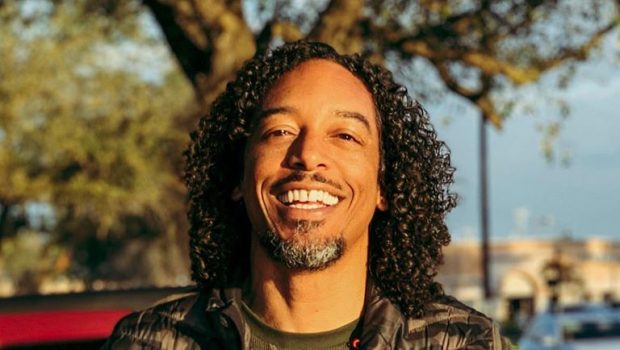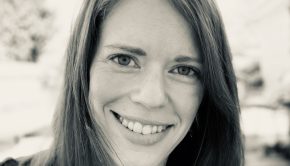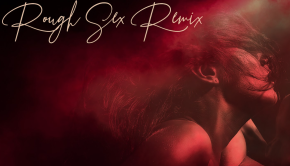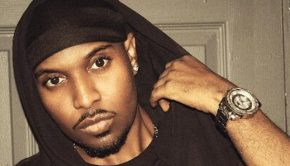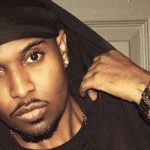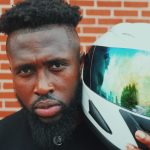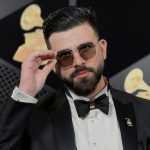Pt. 1: Catching Up With Dr. Garfield Bright from Legendary 90’s R&B Group Shai
Platinum artist, author, activist, philanthropist and doctor. Garfield Bright wears a lot of hats and he’s conquered success down every avenue he’s traveled.
Known as the light skin guy in the quartet Shai, Garfield possessed the looks, a smooth style and a melodic voice that serenaded the airways throughout the 90’s. The 90’s is largely viewed as a time where some of the greatest R&B music ever was created. Four Howard University students cemented themselves amongst those who were providing some profound, “Baby making music,” as it was referred to. “If I Ever Fall In Love,” reached the #2 slot on the Billboard Hot 100. “Comforter,” “Baby I’m Yours,” and “Come With Me,” were also high marks from the quartet as well. Garfield was always a bright (pun intended) spot for the group. He showed off his vocals on the hit single, “Comforter.” Garfield has been very busy since the prominent Shai days. He’s wrote a book, spearheaded several programs that include community involvement and continuing African American education and also obtained his PhD.
I had the honor of catching up with Dr. Garfield Bright to discuss his journey to obtaining his PhD, he talks life outside of music as well as a future solo album.
You have a lot going on, Dr. Garfield. You are still part of the prominent R&B group Shai, but you are busy in activism work and you have obtained your PhD. Update us on everything that you have been doing, my brother.
Dr. Garfield Bright: Wow! Just on my own, we met at Howard, the guys. So, we were college educated brothers in the first place. I always was in love with knowledge and curious about concepts, so I kept matriculating. Even through the Shai years. People didn’t know, I was going back and forth to school. I finally finished my undergrad at Cal State Northridge. We got our record deal right when I had like 3-credits left to finish at Howard. We got a record deal. So, it was between, taking this record deal and going to chase superstardom with a major label. Or do you hold that off… so, I went for mine. When Shai’s star started to dim so to speak, I went back to school. I got my undergrad which was political science history. Then I became a part of something called, “The Hip-Hop Think Team” when I was at Cal State Northridge because, while I was still a student there, the professor knowing that I was in the industry and a platinum guy and understood how it worked. She consulted me to develop a political science class called, “The Politics of Hip-Hop.” I was consulting her and, basically we had a political science class that uses elements in hip-hop to create engagement with students.
Give me an example, my man.
Dr. Garfield Bright: Say for an example, political science, a Presidential candidate. They are supported by a PAC’s [Political Action Committees]. That’s who funds them hoping that the money they put forth will solidify the candidate representing their best interest. And what they do? They throw that money. The same thing happens in music period, but especially in hip-hop when it’s that much competition. It’s called payola. Where you go straight to the program director, the labels are Puffy or somebody, reaches under the table and says, “Look bruh, here is a little something for your troubles, run my artist.” It’s the same kind of dynamic. The students were able to see that kind of similarities in terms of the power dynamic. Then they were able to tune-in and they started looking for parallels. We took cats who were signing up for the class and were hip-hop… putting pen to the pad and writing rhymes, they ended up being like dope research paper writers. They become interested in issues within the landscape of hip-hop like, misogyny, different amendment rights, freedom of speech type stuff. A lot of different things on landscapes that they started writing papers about.
Mine was more centered on education. The black male trying to avoid the prison industrial complex. Who was getting branded as a super predator based on the 80’s narrative. And the hip-hop guys were being looked at. You had the hip-hop “stop and frisk” in New York. All of those things were forming my perspective in terms of education, so I wrote a paper on education. What we did was, we ended up putting it into a journal. We created our own journal, “The Hip-Hop Think Team,” and edited it. Georgia State was known for having its own conference called, “The National Counsel of Black Studies (NCBS).” We got invited. Because hip-hop at that time was a sexy hot button issue in the academic world. Tupac had died and a lot of his stuff was being looked at as poetry and philosophy. So, the hip-hop scene was sexy. So, we are college students at this real academic conference with a hip-hop theme talking about real issues. It kind of got real cache down there. I presented well and did my thing. And the people down there in the African American Studies department at Georgia State was like, “Look man, I know you’re in, Shai and all of that, but we are impressed with academic acumen. If you really wanna go this route, we got room for you in the master’s program. Just holla at us and let us know.”
You had a lot going on. Did you take them up on it?
Dr. Garfield Bright: So, 2-years went by and I’m teaching high school. We still doing shows, Shai shows. But I was teaching at a Charter High School in Lawndale called The Environmental Charter High School. I was supposed to be teaching California history, but I was teaching more of a sociological class. Really like a life class. My first unit I taught was a systems theory. I didn’t even teach the content. I taught systems. I wanted to create interdependence in their mind and show them how natural systems work and how to be a part of one. I introduced them to that. They would accept me as their black male teacher because it was a predominantly Mexican school. So, I wanted them to understand how interdependence worked, so we can jump start from there and then go into these subjects. It worked. They created engagement. So, from there, I ended up getting a master’s at Georgia State in African American Studies department.
After 2-years I did my master’s thesis. We had to do a thesis. It wasn’t like a portfolio or something like that. We actually had to sit there and write a master’s thesis. I did mine on, what is African Centered Education which is what I was exploring. There was a lot of talk about African Centered Education, but what exactly is that? If I expect to send my child to it, what is the essence of that if there is one? I wanted to solve that. I looked at 3-different teachers in the environment. Did observations, I did some document review stuff, and I followed them for a few months in their environment and figured out what the overlaps were to find a sweet spot where I could locate and call African Centering. I ended up getting an “Asa Hilliard Award” for “Outstanding Student in my Cohort,” at Georgia State. My GPA was a 4.03.
You obviously didn’t stop there. You kept going.
Dr. Garfield Bright: I kept matriculating. I went across the street was the department of college education. I applied to the PhD program for educational policy studies. And now my GRE scores are terrible because I’m not a good test taker. But luckily for me, it fell right on the cusp of belief that, these SAT’s and these different types of standardized tests don’t really accurately depict academic performance in college studies. And I had a lot of other compensating strengths. What they did was they brought me in for an interview. And they challenged me. And I was able to stand up for myself, equip myself well with these professors who tested my medal. And they accepted me into the program. I thought I was going to get kicked out right then, but really what they were trying to see was if I had what it takes to defend my dissertation when it comes, and I did. So, they put me in, I matriculated. I was in educational policy studies as a major, but I looked at how a black male navigates in equitable environments. What power is distributed inequitably? I looked at the classrooms… black males situated in a classroom, that power dynamic, and I looked at black males situated in the music industry, based on a contract. Both of those are two sides of myself.
So, what I did is, I interviewed three hip-hop artists that I know, two of which went to HU [Howard University]. D-Dot, Deric Angelettie, people know him as Tha Madd Rapper. He worked for Puffy, he was on a lot of hits with Biggie and stuff. Tracey Lee, who also went to Howard and is an emcee. He was signed to MCA back when we were signed. And this dude called, Akil The MC from this group called, Jurassic 5. I interviewed him. A lot of people think Tupac came back as him. It’s so ridiculous because they were both living at the same time (laughing). Those are my guys. I interviewed Killer Mike and Khnum… Stic.Man from Dead Prez. But I had four different interviews, and they were so busy I couldn’t get them to get all four interviews, so I couldn’t use their data. Originally, I had Killer Mike, Stic.Man from Dead Prez and D-Dot. I had to make some moves. And then I interviewed three kids from my programs that I had created. I found out some interesting things. That dissertation also got an award from my cohort as an, “Outstanding Dissertation,” at Georgia State. And I also maintained a 4.03 GPA in that program.
Wow! You are both intelligent and driven, G. This conversation is so inspiring.
Dr. Garfield Bright: Thanks man. I took the scholarship really seriously. I didn’t walk when I graduated because I refused to be hooded by the establishment. I’m not one of them. I’m Dr. Garfield Bright, but I didn’t do that for the conspicuous status symbol to where I’m hooded, and I’m their guy. Like they brought me in. No! I’m a brother who was curious about my knowledge and proved that I can matriculate at the highest level. Now, what I do is I create programs for the community. I have 3-programs. One called, “I.C.M.E” [I Create My Experience]. One called, “RA INC,” and I was dealing with a program that was brilliant called, “Beyond the Bricks,” that I did not design. But the other two I designed and partnered up with Georgia State. And they are centered around critical literacy, digital literacy and community engagement; like a service-learning component where they give back to the community.
It’s a lot to it. It would take hours to go through it, but we do a community mapping project, that’s part of it. Where we walk around one square mile radius of a neighborhood, access the hazards and resources and then come back to the lab and agree what the hazards and resources are for ourselves. And then go back in the community and interview members of the community on camera. Create a documentary out of that, put a score to it, so they can use their musical talents, and then look at actual the actual thing that they all agreed on as a major issue as a hazard. It might be the wires in the community causing cancer. Or some kind of environmental pollution racism type thing. And the simple fixes might be like pollution or potholes or something like that, where the kids can actually go out and pick up trash or fill up the holes, or whatever the case may be. Then after the interviews and documentary stuff that they have done, they present it at a City Council meeting. You’re representing the community and how rare is that to have young black men or black males say, “This is the voice of the community, we have talked to them and this is what they said.” It’s a counter-narrative producing piece too. So, I piloted it at Georgia State, man… I’m hoping to get this thing poppin’ at the University of Houston, Texas Southern and Yates High School, which are all right next to each other in Houston where I live. This Covid thing kind of slowed those moves down, so I’m waiting for a little space to see if people are going to be back in school or not. All that matters to this kind of thing.
You are also an author. You wrote a book as well.
Dr. Garfield Bright: I did. I wrote a fiction book. After I completed my dissertation in December of 2018, I became Dr. Bright. The whole year of 2019, I was writing a book called, “Lotus 3013,” that I had been carrying around for 10-years. It’s a speculative fiction book. It’s a combination of, Beat Street, The Lord of the Rings and Harry Potter. It’s like in the year 3013, hip-hop is believed to totally be a white cultural product. It has no trace back to blackness at all. It is a lot that goes with that in the year 3013. I’ve also included a lot of my philosophical and sociological stuff around issues of black bodies, black containment… a lot of stuff that I learned in school is in there. I just finished the audiobook of it, and I’m getting a score done to the audiobook, so it will feel like a movie, just without the visual when I finish it. It’s almost done. It’s really dope and it’s a really powerful statement.
You just made this a 2-parter because we haven’t even touched on the music yet, and you have provided us with so much information. You have a lot going on. But we will start here, where are you musically?
Dr. Garfield Bright: Me and Darnell [Van Rensalier of Shai] are getting ready to do a podcast from Charlotte. We are working on some things where we do some interesting stuff. Try to come from a unique angle. So, that will be coming in the near future. Just a few little things and of course the music. I’m working on a solo project and getting songs together. I’m taking my time because I want it to be an eclectic blend of me. It’s called, “The Garfield Bright Experience.” That will be the name of the album and it’s sanctioned by Shai. It’s not like I’m doing some break-up from the group album. The fans been asking me for it for a while and Darnell was like, “You need to gone head and do a joint, man,” so I was like, “Alright. I’ll do a joint (laughing).” It’s happening. I’m trying to get with a lot of different guys. I met some guys down here in Houston. Making some phone calls to see what other producers I can get with. I’ve already done like 20-25 joints. But I want to pick the best 9 out of like 40 songs and make it my album. All of that stuff is going on. I’m in a creative mode right now.
Did you ever fall out of love (no pun intended) with music or was it just time to attack some of these other ventures that you eventually conquered?
Dr. Garfield Bright: Oh nah, music is what sustained me. Even all through my PhD stuff, man…on the weekends, I got a homeboy named, Black in Atlanta where I was doing my PhD work. It would allow me to escape from all of that hardcore reading and writing and analyzing and just go make music on the weekend. And that’s where a lot of that material that I have for the album has come from, those moments. So, no… that’s what kept me sane through all of that. People have no idea how crazy it is to really-really at a high level pursue your PhD. That’s a lot of sacrifice. You need something to help you out going through that. Music was a big one for me.
The fact that you were garnering and seeking knowledge while being a platinum artist, sounds like you learned at a young age how to balance things out and multitask.
Dr. Garfield Bright: I never gave myself credit for that because I always thought I was whack when it came to multitasking (laughing). I think there are certain things, when you are driven, that multitasking muscle doesn’t come as a choice. It’s like you gotta deal with it. When you are in a position where you have to deal with it, if you’re a survivor, you’ll figure out a flow. I think that’s what it was more than anything. I just figured out a way to flow. It really wasn’t because I was just naturally good at it, I don’t think (laughing). I just kind of figured it out.
Be sure to check back for much more with Dr. Bright.
Tweet
